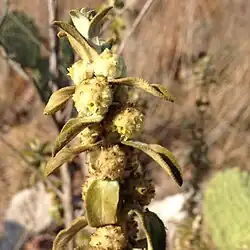Buddleja perfoliata
| Buddleja perfoliata | |
|---|---|

| |
| Scientific classification | |
| Kingdom: | Plantae |
| Clade: | Tracheophytes |
| Clade: | Angiosperms |
| Clade: | Eudicots |
| Clade: | Asterids |
| Order: | Lamiales |
| Family: | Scrophulariaceae |
| Genus: | Buddleja |
| Species: | B. perfoliata
|
| Binomial name | |
| Buddleja perfoliata | |
| Synonyms | |
| |
Buddleja perfoliata is endemic to the xerophytic and subzerophytic grasslands of central Mexico at elevations of 1500 – 2700 m. The species was first named and described by Kunth in 1818.[1][2]
Description
Buddleja perfoliata is a small dioecious shrub 0.8 – 2 m tall in the wild, much branched, and with a greyish-black shredding bark. The young branches are subquadrangular and tomentose, bearing sessile lanceolate to elliptic opposite subcoriaceous leaves, rugose above with dense felt-like tomentum covering both surfaces. The yellow inflorescences, redolent of sage, are 5 – 25 cm long, comprising 5 – 26 pairs of heads borne in the axils of the leaves, each head about 1 cm in diameter with 30 – 40 flowers. Ploidy: 2n = 38.[2]
Cultivation
The species is not known to be in cultivation.